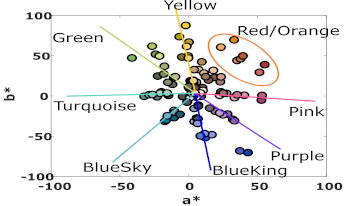
Some natural scenes show a reduced set of colors. These scenes are often encountered in space imaging, for instance for ocean observation which deals with hues of blue and for Mars exploration which deals with hues of “yellowish-brown”. In this context the interest of performing hue-specific (or scene-specific) color corrections for the reconstruction of these images is tested. The study is performed on the Next Generation Target (Avian Rochester, LLC - 130 color patches) for both the color correction matrix computation and efficiency testing. The results show that such hue-specific corrections are efficient on the hues of interest, and evaluate the impact on subsidiary hues.

We are studying a three-dimensional (3D) TV system based on a spatial imaging method for the development of a new type of broadcasting that delivers a strong sense of presence. This spatial imaging method can reproduce natural glasses-free 3D images in accordance with the viewer’s position by faithfully reproducing light rays from an object. One challenge to overcome is that the 3D TV system based on spatial imaging requires a huge number of pixels to obtain high-quality 3D images. Therefore, we applied ultra-high-definition video technologies to a 3D TV system to improve the image quality. We developed a 3D camera system to capture multi-view images of large moving objects and calculate high-precision light rays for reproducing the 3D images. We also developed a 3D display using multiple high-definition display devices to reproduce light rays of high-resolution 3D images. The results show that our 3D display can display full-parallax 3D images with a resolution of more than 330,000 pixels.